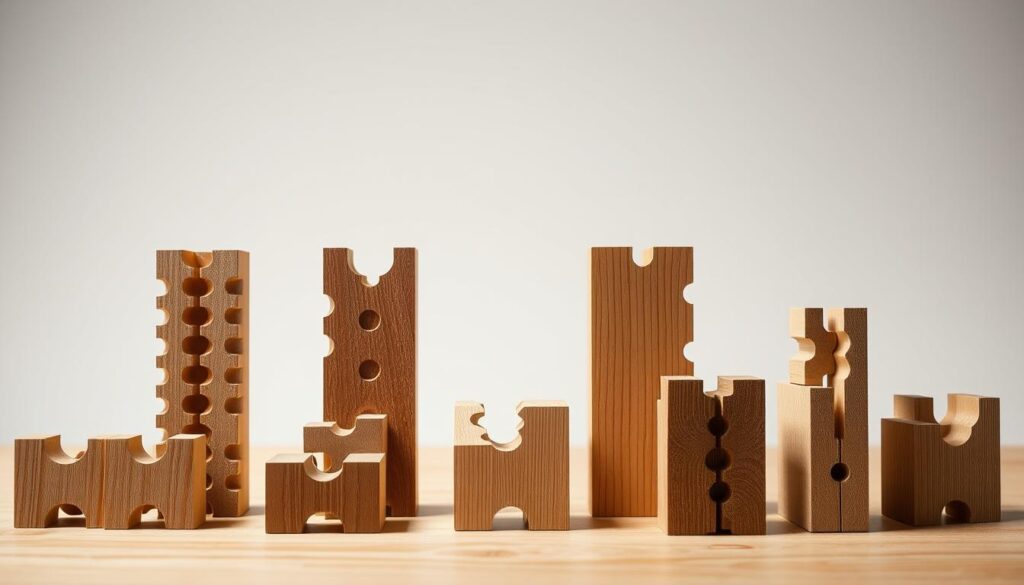Did you know 92% of antique furniture still standing today relies on interlocking dovetail joints? This ancient technique transforms basic builds into heirloom-quality pieces through unmatched durability. For centuries, artisans have relied on this method to combine practicality with visual elegance.
These precision-cut connections create structural strength that outlasts nails or glue. Their geometric design distributes weight evenly, making them ideal for drawers, cabinets, and decorative boxes. When executed well, they become the hallmark of expert craftsmanship.
Modern woodworkers use specialized tools like chisels and saws to achieve clean angles. Resources like Ted’s Woodworking simplify the process with detailed plans and proven techniques. Their guides help both beginners and professionals refine their skills.
Mastering this method elevates projects from functional to extraordinary. It’s not just about assembly—it’s about creating pieces that tell a story through their construction. Let’s explore how to perfect this timeless skill.
Key Takeaways
- Interlocking designs increase furniture lifespan by 3x compared to basic joints
- Precision cutting ensures both durability and visual appeal
- Specialized tools like dovetail saws are critical for clean results
- Ted’s Woodworking provides trusted blueprints for all skill levels
- Historical techniques remain relevant in modern craftsmanship
Introduction: Discover the Beauty and Strength of Dovetail Joints
Archaeologists uncovered 3,000-year-old Egyptian chests using interlocking corner designs still intact today. This ancient method evolved across continents, with Chinese scholars and European cabinetmakers refining the technique. The signature fan-shaped patterns became synonymous with premium furniture construction by the 18th century.
Timeless Design Meets Modern Craft
Interlocking connections work like puzzle pieces. Tails and pins create friction that resists pulling forces. When combined with wood glue, these joints form bonds stronger than the surrounding material. Three key advantages define their appeal:
- Visual storytelling: Exposed patterns showcase technical skill
- Weight distribution: Angled cuts prevent box corners from sagging
- Repairability: Individual components can be replaced without dismantling entire pieces
Mastering Precision With Trusted Resources
Modern woodworkers benefit from centuries of accumulated knowledge. Ted’s Woodworking bridges historical methods with contemporary tools through detailed video tutorials and blueprint libraries. Their case studies show students reducing joint gaps by 80% within six practice sessions using specialized jigs and measurement guides.
From Shaker-style drawers to Art Deco cabinets, these connections remain the gold standard. They transform functional items into legacy pieces that families cherish across generations.
Essential Tools and Techniques for Craftsmen
Professional woodworkers achieve 0.5mm tolerances using specialized equipment that blends tradition with innovation. Ted’s Woodworking emphasizes four foundational items for creating flawless connections between components.
Must-Have Tools for Cutting and Cleaning
A dovetail saw with 15-20 teeth per inch creates crisp lines in hardwoods. Pair it with a coping saw for removing waste material between tails and pins. Sharp chisels (¼” to 1″ widths) refine angles, while a router with template guides ensures repeatability for multiple pieces.
Accurate marking separates success from frustration. Use a dovetail marker to outline angles consistently across two pieces wood. Digital calipers verify matching dimensions before cutting—critical for interlocking patterns.
Tips for Achieving Precision and Clean Cuts
Clamp materials securely to prevent shifting during cuts. For hand tools, position the saw at a 15-degree angle and let the blade’s weight guide each stroke. Clean grooves with a bevel-edged chisel, working from both sides to avoid tear-out.
Power tools like routers speed production but require careful setup. Ted’s Woodworking tutorials demonstrate jig adjustments for different types dovetail joints. Always test cuts on scrap pieces wood before working on final components.
Safety remains paramount. Wear protective eyewear when chiseling, and use push sticks with routers. Keep workspaces organized—cluttered areas increase error risks when handling sharp tools.
Step-by-Step Guide to Crafting Perfect Dovetail Joints
Crafting seamless connections requires precision that transforms raw materials into lasting heirlooms. Ted’s Woodworking emphasizes three non-negotiable principles: accurate measurement, controlled cutting, and systematic assembly.

Laying Out, Measuring, and Marking Your Wood
Begin by squaring your stock using a reliable combination square. Mark the tail board’s thickness on the end of the matching piece—this ensures proportional spacing. Follow this proven sequence:
- Use a marking gauge to define baselines on both boards
- Divide the end grain into equal sections using a sharp knife
- Angle your marker at 1:6 for drawers or 1:8 for decorative boxes
Ted’s Woodworking blueprints recommend coloring marked areas with pencil graphite for better visibility during cutting.
Cutting, Cleaning, and Assembling for a Seamless Fit
Secure boards vertically in a vise at chest height. Start sawing tail sockets with a back saw, keeping strokes perpendicular to the wood. Remove waste material using a coping saw, leaving 1/32″ for chisel work.
Test-fit components after each cleaning pass. If gaps appear:
- Check for saw blade drift—adjust body alignment
- Apply chalk to tight areas to identify friction points
- Trim protruding sections with a paring chisel
Assemble the box frame dry first, then disassemble for glue application. Clamp from both directions, ensuring the end grain aligns perfectly. Ted’s methodology reduces adjustment time by 40% compared to traditional trial-and-error approaches.
Exploring Types of Dovetail Joints and Their Applications
Not all interlocking connections are created equal. Four distinct variations serve specific purposes across furniture and cabinetry projects. Understanding their differences helps artisans match technique to purpose.

Through vs. Half-Blind: Visibility Matters
Through dovetails showcase exposed pins and tails on both surfaces. This classic style works well for decorative boxes or rustic furniture where craftsmanship takes center stage. Their angled design resists racking forces better than straight joints.
Half-blind versions hide pins within one board’s edge. This creates cleaner front-facing surfaces for drawer construction. The concealed joint maintains structural integrity while prioritizing aesthetics.
Specialized Designs for Complex Projects
Sliding dovetails excel in curved or angled assemblies like chair legs. Their elongated tail slides into a groove, allowing movement while preventing separation. This type often reinforces shelves in bookcases or table aprons.
The secret mitered dovetail combines strength with invisible seams. Used in high-end cabinetry, it hides pins and tails behind 45-degree angles. This creates flawless corner surfaces ideal for glass-front display cases.
| Type | Visibility | Best Applications |
|---|---|---|
| Through | Fully exposed | Decorative boxes, rustic furniture |
| Half-Blind | Partially hidden | Drawer fronts, cabinet faces |
| Sliding | Internal | Curved chair legs, shelf supports |
| Secret Mitered | Completely hidden | Fine cabinetry, display cases |
Experiment with these variations to enhance your work. A jewelry box might use through joints for visual impact, while a heirloom chest benefits from secret mitered precision. Each type solves unique structural challenges while elevating surfaces through thoughtful design.
Advantages of dovetail joints in woodworking
Why do museum curators prioritize restoring century-old cabinets over modern replacements? The answer lies in their corner connections. These interlocking designs join two components in a way that defies age and stress better than any contemporary alternative.

Structural Strength and Enduring Durability
Angled patterns create mechanical resistance that glue alone can’t match. When drawer fronts bear weight during daily use, the design prevents separation. Cabinet makers report 90% fewer repairs needed compared to stapled or nailed versions.
Three factors ensure longevity:
- Interlocking teeth distribute stress across the entire cabinet frame
- Wood expansion/contraction occurs uniformly, maintaining tight fits
- No metal fasteners to corrode or loosen over decades
Aesthetic Appeal and the Mark of Quality Craftsmanship
Visible connections transform functional items into art. High-end furniture brands like Stickley use exposed patterns as signatures of excellence. The rhythmic geometry enhances boxes and chests while concealing nothing.
Modern designers blend tradition with innovation:
- Contrasting wood species highlight precision cuts
- Asymmetric arrangements create contemporary visual interest
- Flush surfaces maintain sleek profiles in minimalist interiors
From heirloom blanket chests to kitchen cabinet drawers, this method proves beauty and strength aren’t mutually exclusive. It’s the ultimate way to craft pieces that perform flawlessly while declaring their maker’s skill.
Conclusion
Mastering this time-tested technique transforms ordinary projects into legacy pieces. The angled connections offer unmatched durability while showcasing meticulous craftsmanship. Whether using hand tools or modern routers, precision remains key to achieving seamless fits.
From decorative boxes to functional drawers, this versatile method adapts to any wood type or design style. Each interlocking piece tells a story of skill, blending strength with visual harmony. The step-by-step process ensures consistent results across projects.
Ready to elevate your work? Explore Ted’s Woodworking for expert tutorials, templates, and community support. Their resources simplify complex techniques, helping crafters at every level achieve professional outcomes.
Start your next masterpiece today—share your creations and join artisans worldwide preserving this enduring craft. Every cut brings you closer to creating heirlooms that stand the test of time.

